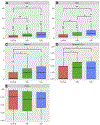Bladder bacterial diversity differs in continent and incontinent women: a cross-sectional study
- PMID: 32380174
- PMCID: PMC7609606
- DOI: 10.1016/j.ajog.2020.04.033
Bladder bacterial diversity differs in continent and incontinent women: a cross-sectional study
Abstract
Background: Since the discovery of the bladder microbiome (urobiome), interest has grown in learning whether urobiome characteristics have a role in clinical phenotyping and provide opportunities for novel therapeutic approaches for women with common forms of urinary incontinence.
Objective: This study aimed to test the hypothesis that the bladder urobiome differs among women in the control cohort and women affected by urinary incontinence by assessing associations between urinary incontinence status and the cultured urobiome.
Study design: With institutional review board oversight, urine specimens from 309 adult women were collected through transurethral catheterization. These women were categorized into 3 cohorts (continent control, stress urinary incontinence [SUI], and urgency urinary incontinence [UUI]) based on their responses to the validated Pelvic Floor Distress Inventory (PFDI) questionnaire. Among 309 women, 150 were in the continent control cohort, 50 were in the SUI cohort, and 109 were in the UUI cohort. Symptom severity was assessed by subscale scoring with the Urinary Distress Inventory (UDI), subscale of the Pelvic Floor Distress Inventory. Microbes were assessed by expanded quantitative urine culture protocol, which detects the most common bladder microbes (bacteria and yeast). Microbes were identified to the species level by matrix-assisted laser desorption and ionization time-of-flight mass spectrometry. Alpha diversity indices were calculated for culture-positive samples and compared across the 3 cohorts. The correlations of UDI scores, alpha diversity indices, and species abundance were estimated.
Results: Participants had a mean age of 53 years (range 22-90); most were whites (65%). Women with urinary incontinence were slightly older (control, 47; SUI, 54; UUI, 61). By design, UDI symptom scores differed (control, 8.43 [10.1]; SUI, 97.95 [55.36]; UUI, 93.71 [49.12]; P<.001). Among 309 participants, 216 (70%) had expanded quantitative urine culture-detected bacteria; furthermore, the urinary incontinence cohorts had a higher detection frequency than the control cohort (control, 57%; SUI, 86%; UUI, 81%; P<.001). In addition, the most frequently detected species among the cohorts were as follows: continent control, Lactobacillus iners (12.7%), Streptococcus anginosus (12.7%), L crispatus (10.7%), and L gasseri (10%); SUI, S anginosus (26%), L iners (18%), Staphylococcus epidermidis (18%), and L jensenii (16%); and UUI, S anginosus (30.3%), L gasseri (22%), Aerococcus urinae (18.3%), and Gardnerella vaginalis (17.4%). However, only Actinotignum schaalii (formerly Actinobaculum schaalii), A urinae, A sanguinicola, and Corynebacterium lipophile group were found at significantly higher mean abundances in 1 of the urinary incontinence cohorts when compared with the control cohort (Wilcoxon rank sum test; P<.02), and no individual genus differed significantly between the 2 urinary incontinence cohorts. Both urinary incontinence cohorts had increased alpha diversity similar to continent control cohort with indices of species richness, but not evenness, strongly associated with urinary incontinence.
Conclusion: In adult women, the composition of the culturable bladder urobiome is associated with urinary incontinence, regardless of common incontinence subtype. Detection of more unique living microbes was associated with worsening incontinence symptom severity. Culturable species richness was significantly greater in the urinary incontinence cohorts than in the continent control cohort.
Keywords: biodiversity; continence; enhanced urine culture; human microbiome; stress urinary incontinence; urgency urinary incontinence; urinary incontinence; urobiome.
Published by Elsevier Inc.
Figures




References
Publication types
MeSH terms
Supplementary concepts
Grants and funding
LinkOut - more resources
Full Text Sources
Medical

